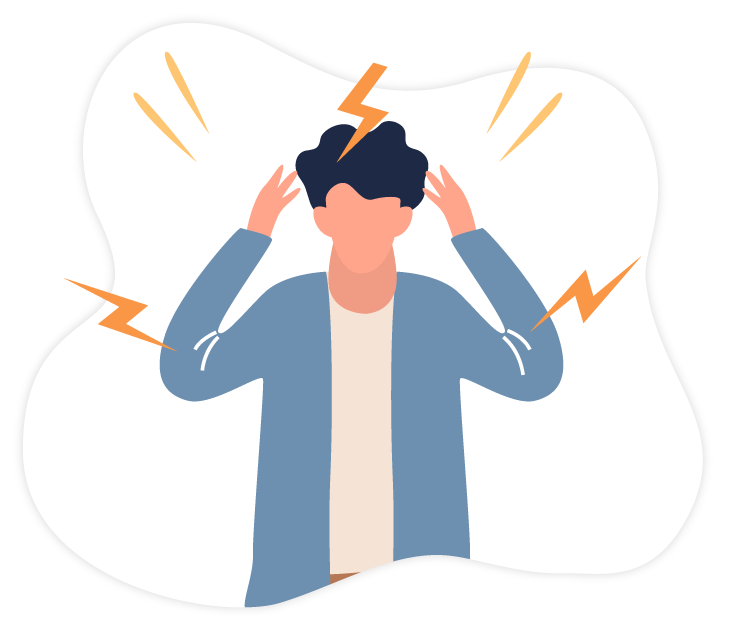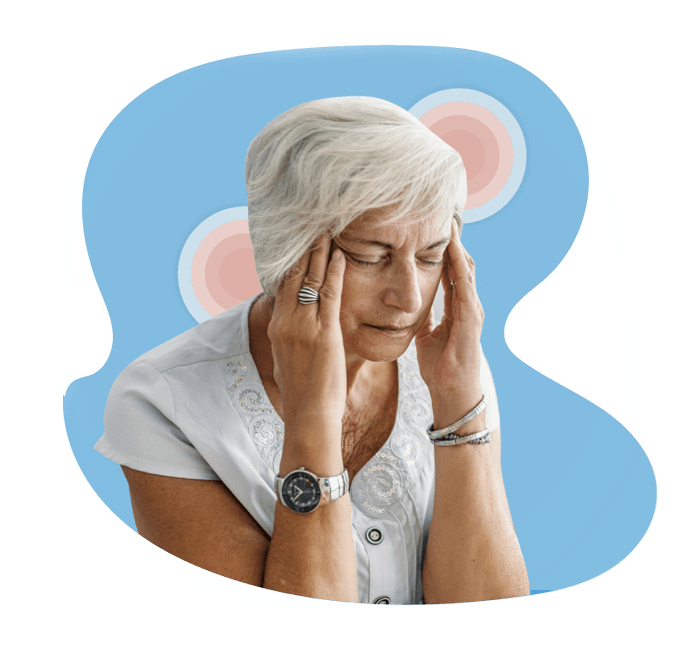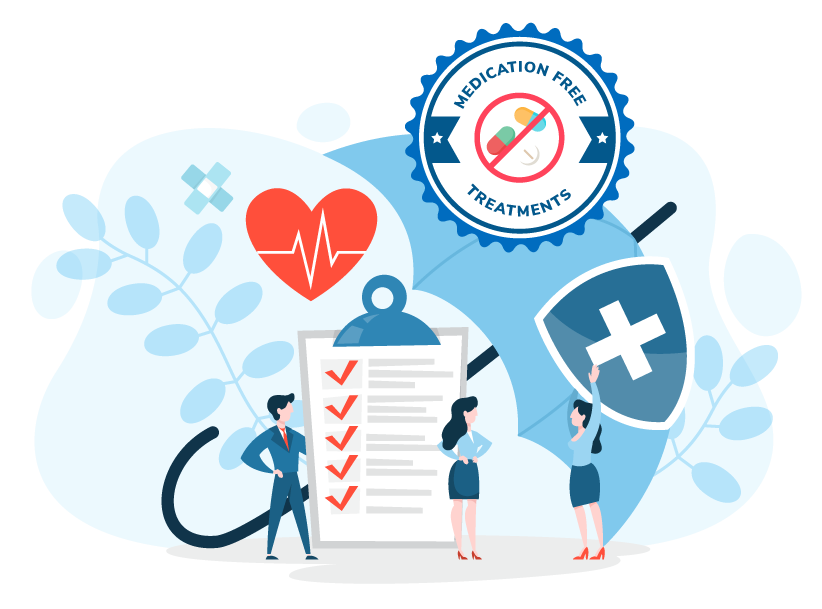Cervicogenic Headache
Cervicogenic Headache is classed as a secondary headache, as the symptoms arise from the upper cervical spine. Dysfunctions or injury to structures in the neck, like discs and joints, are able to produce pain in the head through their connection to the brainstem via afferent nerves. As this information reaches the brainstem it converges with information from the head and face. It is this miscommunication of information that causes cervicogenic headache.
Pain is often unilateral, and associated with pain or stiffness in the neck. People who experience cervicogenic headache may also experience; nausea, vomiting, dizziness and tinnitus. Treatment is usually focused around addressing the cervical spine dysfunctions, but may ignore the brainstem altogether.
Chronic Daily Headache
Chronic Daily Headache is the most common headache type affecting between 30-80% of the Brisbane population. There are four common types of Chronic Daily Headaches. These include Chronic Tension-Type Headache, New Daily Persistent Headache, Chronic Migraine and Hemicrania Continua. In most cases these headaches are a result of a problematic upper cervical spine.
Symptoms can range from mild to moderate, and can induce headaches similar to Tension Type Headaches or Migraines anywhere in the head, neck or face region.
Learn more on the differences between the four common Chronic Daily Headache Types, and what can be done by those suffering from these persistent headaches. Imagine living a life free from headaches and migraines and saying goodbye to medications!
Cluster Headache
While Cluster headaches are very rare, affecting only 0.1% of the population, they are frequently described as the most severe and debilitating headache type. Cluster headaches often occur in cycles, with attacks occurring at regular times at night, or like clock-work during the day. Attacks are very intense and can last up to 3 hours before settling. Sufferers will often experience this pattern for long periods of time, before experiencing periods of remission with no attacks at all.
Pain is often unilateral, severe and local to a small area of the head. Associated symptoms include; a blocked or runny nose, red or watery eyes and droopy eyelids. Because of the severe and debilitating nature of these headaches, they are often referred to as “suicide headaches”.
Cyclical Vomiting Syndrome
The main presentation of Cyclical Vomiting Syndrome (CVS) is episodes of severe vomiting followed most often by complete symptom-free periods, hence the cyclical nature of the disorder. However, occasionally sufferers may experience mild symptoms in between. The episodes can last anywhere from 1 hour up to 10 days. Within each episode, the sufferer will vomit at least 4 times per hour, and an attack can last 1 hour-10 days, which can often lead to severe dehydration. Notably, the episodes present similarly in terms of duration, time of onset, intensity and type of symptoms as well. CVS is more common in children, with children ages 3-7 most affected. Some cases of CVS can occur in adults as well.
Hormonal Headache
Approximately 60% of female migraine sufferers experience their symptoms during their menstrual cycle, and for 14%, this is the only time that they get their symptoms. As with other migraine types, symptoms are often moderate-severe, unilateral and can include; nausea, vomiting and sensitivity to light, sound and smell.
Modern research has shown that people who experience hormonal migraines, have no difference in their hormone levels when compared to people who don’t experience them. Furthermore, there seems to be no change in symptoms when they are treated with Hormone Replacement Therapy or the contraceptive pill.
Occipital Neuralgia
Originating in the brainstem, in the upper cervical spine, the occipital nerve supplies a large part of the skull and parts of the face. For various reasons, branches of the occipital nerve can become compressed or irritated, causing considerable pain along their distribution. This is called Occipital Neuralgia. Typically, the occipital nerve can become affected by surrounding structures, like; aberrant blood vessels, osteophytes surrounding cervical joints or growths like carcinomas.
Symptoms of Occipital Neuralgia include; a unilateral, piercing pain along occipital branch distributions, skin sensitivity to very light touch, pain behind the eyes and nausea.
Often the patients we see will not have any known cause for their symptoms, learn more about Occipital Neuralgia and a modern treatment technique that may work for you!
Sinus Headache
Your sinuses are a series of cavities located behind your nose, eyes and cheeks. Their main purpose is to provide airflow and to aid in clearing out pathogens by draining mucous. Inflammation of the sinuses can cause an over production of mucous, and often happens as a reaction to a pathogen in the body, like; dust or pollen. As this reaction occurs, the increase in pressure can be felt as a headache, or pain in the face.
Symptoms of sinus headache are often felt bilaterally, and they will often be experienced along with; a runny or blocked nose, watery eyes and pressure felt in the sinuses.
In cases where sinusitis, and the resulting headache, is caused by little or no pathogen involvement it is possible that a hyper-sensitive brainstem is the true cause of your symptoms.
Tension Type Headache
According to the International Headache Society, Tension Type Headache is the most common type of primary headache, which accounts to almost 90% of all headache types. It has a lifetime prevalence worldwide ranging up to 78%.
Tension Type Headache is usually felt by a constant pressing, tightening and squeezing discomfort on both sides of the head. Sufferers normally describe their pain as if they were wearing a tight helmet, which can become tighter and tighter around their head. The pain intensity can range from mild to moderate and can last anywhere between 30 minutes and up to 7 days. Nausea or vomiting is not a feature of tension type headache however, sensitivity to light or sound can be.
Trigeminal Neuralgia
Trigeminal Neuralgia is commonly described a sharp, shooting or stabbing pain that is experienced on one side of the face. This pain is often brough on by very light touch around the face, or by mundane activities, like; chewing, brushing your teeth or even speaking. Due to the low threshold for Trigeminal Neuralgia to be aggravated, symptoms can occur up to 50 times per day.
Classical Trigeminal Neuralgia refers to the compression of the trigeminal nerve roots from blood vessels. Secondary trigeminal neuralgia refers to pain that is caused by another condition, such as; multiple sclerosis, tumours or other growths. However, a lot of the patients we see do not have a known cause, and are classified as Idiopathic Trigeminal Neuralgia.
Whiplash Headache
Whiplash is an injury that is commonly sustained by people in car accidents, or as part of sporting and diving injuries. It is classically a deceleration injury that will strain the joints, muscles, ligaments and discs in the spine. Whiplash can be complex due to the high-velocity at which it occurs, and the wide area of the body that can be affected. Headaches are a common symptom of a whiplash injury, primarily due to dysfunction caused to the upper cervical spine.
Whiplash can cause many different types of headache, including; cervicogenic headache, migraines and tension-type headaches, but can also be categorised by the length of time suffered. ‘Acute whiplash headaches’ refer to headaches or migraines that start within 3 months of the injury occurring, and ‘persistent whiplash headaches’ are headaches or migraines that last for longer than 3 months.
Treatment should be targeted at addressing the underlying cause.







